Introduction about Isfahan Khaju Bridge
Isfahan Khaju Bridge is one of the most beautiful and historic bridges in Isfahan. This bridge has amazing architecture and high stability.
This article is one of a series of articles on the HotelOneClick site, designed to provide travelers with more information about Isfahan tourist attractions.

Khaju Bridge is one of the most spectacular sites in Isfahan. You shouldn’t miss visiting it when you are in Isfahan.
You may have seen photos of Khaju Bridge over and over again and also admired the beauty of this bridge and its clever structure.
But you should know that the secrets of Khaju Bridge in Isfahan are among its wonders.
The secrets of this bridge have made many curious to know the name of the creator of the Khaju Bridge and its structure.
To get acquainted with other tourist sites in Isfahan, you can use Iran Tourism Guide. This guide is available on the HotelOneClick site.
- Why Isfahan Khaju Bridge is one of the tourist attractions of Isfahan?
- Getting to know Khaju Bridge, Zayandehrood amazing pass
- Khaju Bridge; a place to have fun
- Khaju Bridge, an old resort
- Secrets of Khaju Bridge
- 1. Water-friendly Bridge
- 2. kiblah Finder
- 3. Khaju Candle
- 4. The mysterious tombstones
- 5. Khaju Eagle
- 6. Strange signs
- History of Paul Khaju
- 1. Construction of the bridge during the time of Shah Abbas
- 2. Khaju Bridge finds other uses as well
- 3. Khaju Bridge in the Qajar Period
- Architecture and Structure of Khaju Bridge
- 1. The length of the Khaju Bridge and the number of openings
- 2. The secret of the strength and stability of the bridge over the centuries
- 3. Principles used in the construction of the Khaju Bridge
- 4. Materials used in the Khaju Bridge; smart selections
- The History of the Naqsh-e Jahan Square
- Khaju - a bridge that served as a dam
- The way of turning a bridge into a dam
- Khaju; the bridge that was the king's temporary residence
- Access ways to Khaju Bridge
- The ruined buildings of Naqsh-e Jahan
- Foreigners' comments on Khaju Bridge
- HotelOneClick Concerns
- Conclusion
Why Isfahan Khaju Bridge is one of the tourist attractions of Isfahan?
If you haven't had a detailed look at the bridge to date, join the HotelOneClick to check it out closely.
There are many reasons why Khaju Bridge has made Isfahan one of the most visited tourist attractions in Iran. Following are some of the reasons:
- Khaju Bridge is one of the historic bridges of Isfahan which is considered as the most beautiful bridge of Zayandehrood and Isfahan.
- Walking over this bridge can create one of the most enjoyable moments for you.
- The area around the bridge at dusk and early night is a place for people to have fun.
- It has been one of the most beautiful bridges in the world in its time.
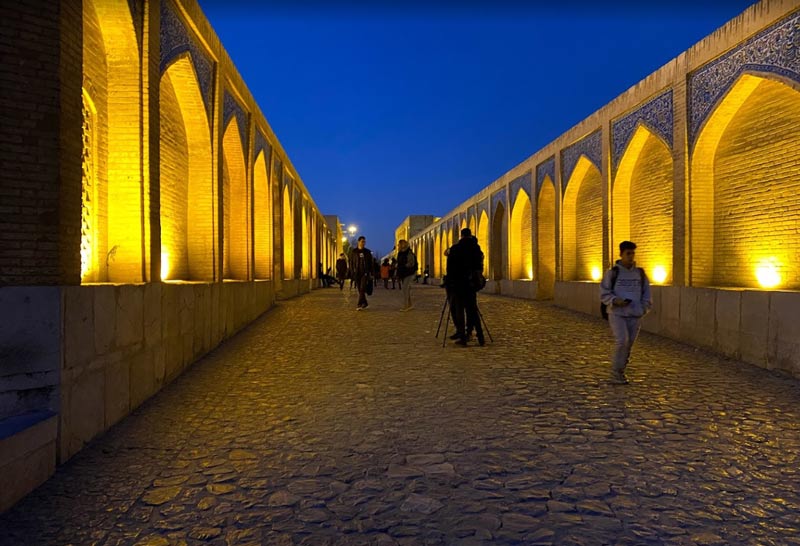
Getting to know Khaju Bridge, Zayandehrood amazing pass
Khaju Bridge is one of the few bridges on Zayandehrood which is known as the most beautiful bridge in Isfahan. This bridge is in the east of Si-o-se-pol.
In addition to eye-catching architecture, it also exhibits beautiful views. The middle part shines like a gem.
The bridge was built on the orders of Shah Abbas II of Safavid era on the ruins of the Hasan Beik bridge of the Teymurid era.
The Khaju Bridge was renowned for its architectural features and the use of tile decoration as one of the most beautiful bridges of the world in its time.
It is good to know that this bridge was also a crossing point. The building, known as the Shah Neshin, also served as the temporary residence of the king, and at times it was used for the dam.
Due to the value of this monument, its name has been listed in the National Iranian Monuments List since January 15, 1932.
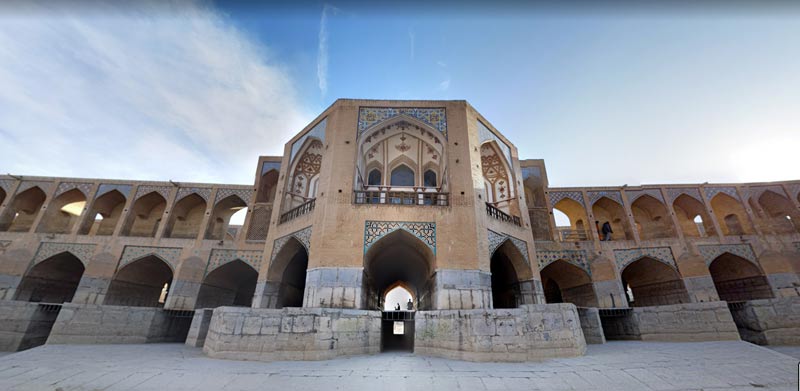
Khaju Bridge; a place to have fun
Some architectural references point out that Khaju Bridge had a function similar to the Tehran Nature Bridge.
This bridge was not just a simple passageway. The bridge is designed for people to stop in each corners and have fun together.
If you would like to find out more about the Tehran Nature Bridge, see the Tehran Nature Bridge Tourism Guide.
People go to the bridge in the evening and at night to create happy moments. Walking on the bridge is one of the city's favorite tourist activities. It is a pleasure to watch its different effects.
There is always a lot of joy and happiness in the bridge. From musicians who play something to kids who create a different atmosphere with laughter and joy.
Authorities occasionally carry out specific programs on the bridge. Among them three-dimensional lighting in Nowruz can be mentioned.
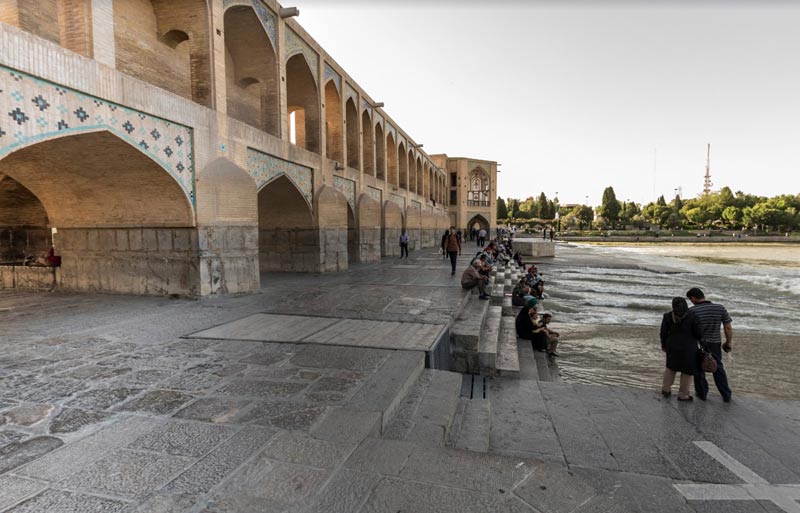
Khaju Bridge is one of the most beautiful amusement places in Isfahan. If you have not yet traveled to Tehran, you can select the hotels in Isfahan by booking Isfahan hotels.
Khaju Bridge, an old resort
It is good to know that in historical sources, bridge decoration and celebration in it have been mentioned frequently.
For example, in the book Ghesas al-Khaqqani, compiled by Vali Gholi Beig Shamloo, it is quoted that from the Safavid history:
In 1650, the bridge was built and became known as Shahi Bridge. After the Nowruz holiday of that year, under the command of Shah Abbas II, the bridge was decorated and lightened.
Each of the corridors was decorated by one of the masters and elders and prepared for the celebration.
The poets of Mashhad have composed poems and Saeb Tabrizi also wrote poems about the lightings and celebrations.
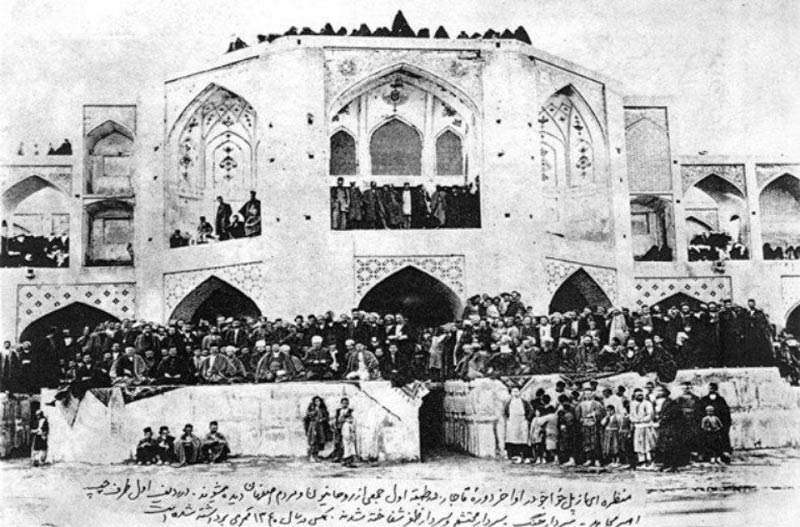
Secrets of Khaju Bridge
Apart from the amazing architecture and construction principles of the bridge, there are some interesting facts about Khaju Bridge. We will refer to them later.
Of course, these are only part of the bridge’s wonders. The more amazing facts can be found in the architecture section.
1. Water-friendly Bridge
The columns of Khaju Bridge needs water for stability. Not only does water erode it, it also strengthens it.
2. kiblah Finder
On the eastern side of the bridge, there are two stone lions. These lions are probably the symbol of Bakhtiari's troops and the guard of Isfahan in the Safavid era.
Close to the statue of the lion and on a stone bed on the north side of the bridge, a sun-shaped kiblah Finder is built.

3. Khaju Candle
One of the funniest secrets lies in its candles. Stand on the lower floor of the bridge and at the end of the edge.
Take a look at the composition of the arches, the seating areas and the walls at a 39-degree angle to the horizon.
You will notice a candle that emerges from the combination of this three-dimensional space and from where the rear and front walls collide.
This candle is full and has tears on it, indicating a particular philosophy.
4. The mysterious tombstones
In excavations carried out in 2010 for the restoration and reconstruction of the bridge, very exquisite and ancient tombstones were discovered along with a large number of carved boulders with strange symbols.
Most of them were destroyed during the same operation, and some were transferred to the Steel Flat Museum where they are kept.
5. Khaju Eagle
If you look at the bridge from above, its structure is like an eagle as if it is opening its wings and flying over Zayandehrood.
The notches of different floors of the bridges resemble the eagle feathers. The second floor Shah Neshin looks like the eagle's head.
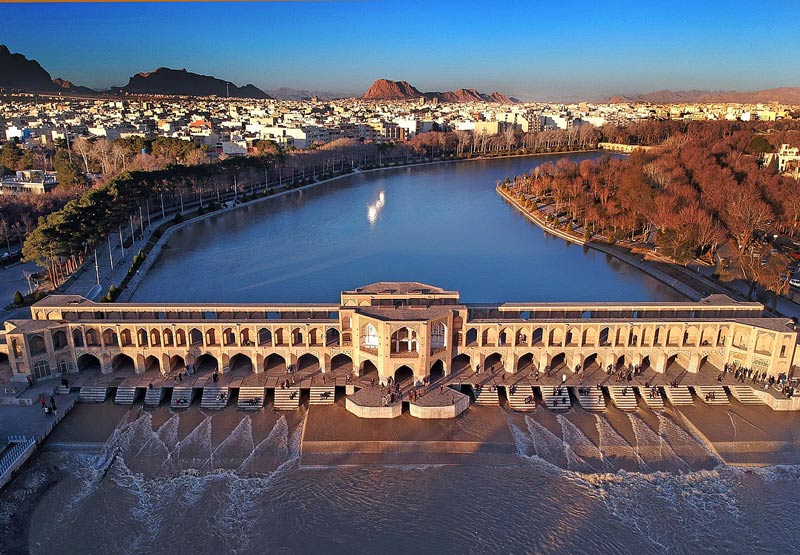
6. Strange signs
With a little attention to the stones of the lower floor of the bridge, we notice strange signs.
It is not clear who has carved these signs.
There is much talk about these signs. Some people think each of these signs was specific to a Safavid stone sculptor.
This will determine the number of carved stones by each person and his wages at the end of the work. Others consider them to be letters of the Greek alphabet.
They believe that in the Safavid era, the ruins of the Sassanid palaces were used in the construction of the Khaju Bridge in the Isfahan Jey area.
Some of the stone sculptors were Greek. However, the truth is not yet clear. This mystery still occupies many minds.
History of Paul Khaju
What is today known as the Khaju Bridge. It was built on the ruins of a bridge by Shah Abbas II in the year 6 AH. The bridge from the Timurid era was named Hasanbeik.
According to historical records, the bridge existed before the Islamic State. The bridge was repaired during the Turkmens and reached its peak in the Safavid era.

1. Construction of the bridge during the time of Shah Abbas
Historical writings say: Because this part of Zayandehrood is deeper than other parts of it, Shah Abbas chose this place.
This bridge caused Zoroastrians whose neighborhood was across the river to no longer go to the Chaharbagh Street to cross the Zayandehrood and take a shorter route from the bridge.
According to the writings, there were two houses on both sides of the bridge for the king. Shah Abbas chose the name Hassan Beik when the bridge was completed.
According to some historians, in the present location of Khaju bridge, there was a waste and unused bridge.
King Abbas II ordered that a bridge be built on the bridge in accordance with a specific plan.
Its location was near the Saadat Abad garden and the Ayeneh Khaneh Mansion. The staff was required to make the bridge more beautiful and to build the best of it.
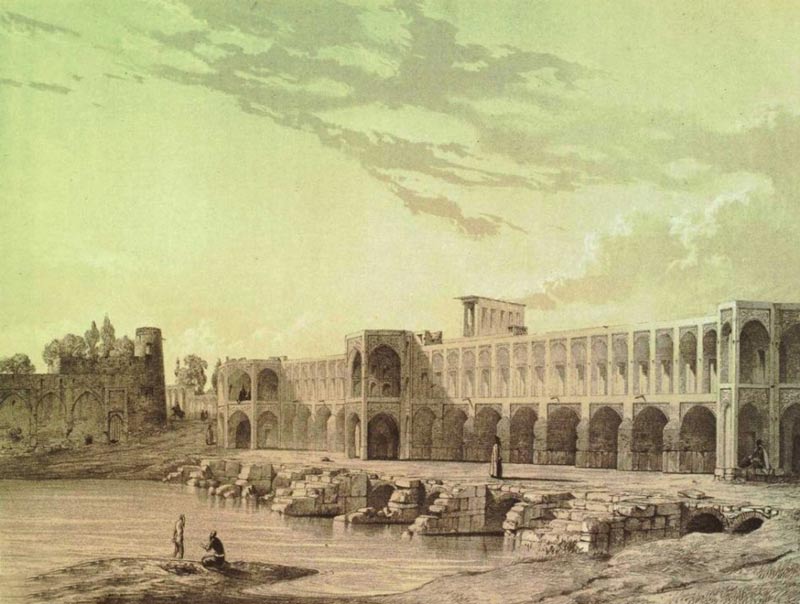
2. Khaju Bridge finds other uses as well
According to scholars, initially the purpose of Shah Abbas II of building the Khaju bridge was to make connections between Khaju neighborhood and the Hassan Abad Gate with Takht Foolad and the Shiraz Road.
It was then decided that the bridge would not have the role of a bridge only. It could also be used as a dam when necessary.
Therefore, in 1658, dams were also made for it. If closed, water would accumulate and form a lake on one side of the bridge.
In the midst of this, Shah Abbas built a place for a short stay for himself and his family. So that they enjoy the scenery around.
Throughout history, the bridge has played the role for commuting between the two sides of Zayandehrood. It also has other uses.
These include the following:
- Watching boat riding matches
- Being a resort for people
- Being a place to entertain the King and his family
3. Khaju Bridge in the Qajar Period
At the time of Biglarbeigi Sadr Isfahani - the third chieftain of Fath Ali Shah between 1819 and 1824 a place was built in his name.
In 1892, Zal al-Sultan, the son of Nasser al-Din Shah, ordered its destruction. According to the Kufic inscription on the south side of the bridge, the Khaju Bridge was restored in 1873.
This restoration coincided with the reign of Nasser al-Din Shah Qajar and with the help of a politician named Nasrollah Khan.

You can stay at Isfahan Parsian Kosar Hotel in Isfahan to stay in Isfahan and also visit this beautiful square. If you have not booked your hotel yet, you can book Parsian Kosar Hotel in Isfahan now.
Architecture and Structure of Khaju Bridge
One of the things to note when considering the Khaju Bridge is the amazing architecture of the structure. Here are some of its features:
1. The length of the Khaju Bridge and the number of openings
There is disagreement about the length of the bridge and the number of openings. For example, Tavernier, European Tourist talks about it like this:
The bridge is 150 meters long and 7.5 meters’ width and its crossing is 1.5 meters. The bridge is made of stone and brick and has 21 jugs and 26 openings.
But what we see in today's books is 132.5 meters long and 12 meters’ width. Of course, the number of openings on this bridge has been written in different numbers of 26,24,21 and 28.
Accordingly, it may have undergone some changes throughout the history of the bridge and some parts of it have been lost.

2. The secret of the strength and stability of the bridge over the centuries
The strength and durability of this old bridge are affected by many factors. Here are some of them:
Foundation of the Bridge
In terms of foundations, the bases of the Khaju Bridge are on a rock composed of large rounded pieces called the conglomerate. It creates a resistant layer of rock.
During construction, sand layers have been removed by the river at the bridge site. Then they built a bridge over a layer of conglomerate.
The riverbed has been paved around the foundations of the bridge.
This has minimized the destructive effects of water such as erosion and destruction.
The brilliance of the bridge designer has caused no signs of erosion be seen at the foot of the bridge today.
Barrel vault and cupola domes
The vault is on the pedestals or the roof over which the bridge crossing is.
This vault is composed of barrel vault and cupola dome.
Barrel vault or cradle vault is one of the ancient arches of Iran.
The arch is formed by applying an arc on two parallel walls.
Cupola dome is a circular cover that is used for the under cover of the monuments.
The use of this form in the bridge structure provides excellent bearing and stability. This form must have been of interest to the architects for repeated use over the centuries.
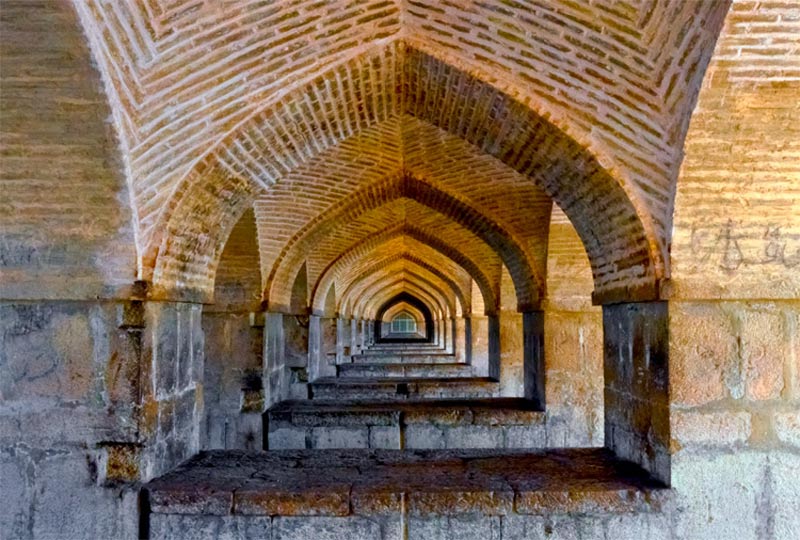
Accurate calculations
By examining the large, precise, heavy foundations of the Khaju Bridge, we find that the dimensions of the bridge are well calculated in all respects. Despite its high weight, it has withstood the water pressure for many years.
The water movement in the river and the water stagnation around the foot of the bridge could endanger the life of this structure. Weight is a factor in resisting these pressures, but not enough alone.
In the Khaju Bridge, the high level of bridge connectivity to the riverbed and the shape of the bridge foundations also play a significant role in this strength.
The slip of the pedestals, the overturning, and so on makes no sense for Khaju bridge.
Gutters and stairs
The sharp shape of the pedestals above the bridge is like a groove. As a result, the pressure from the river flow to the bridge is minimized.
The pedestals of the bridge have a staircase shape. This allows water to flow from the pedestals during floods or closures due to the dams.
When water passes through the stairs, it loses its energy. So when it reaches the riverbed, it has no destructive and corrosive energy.
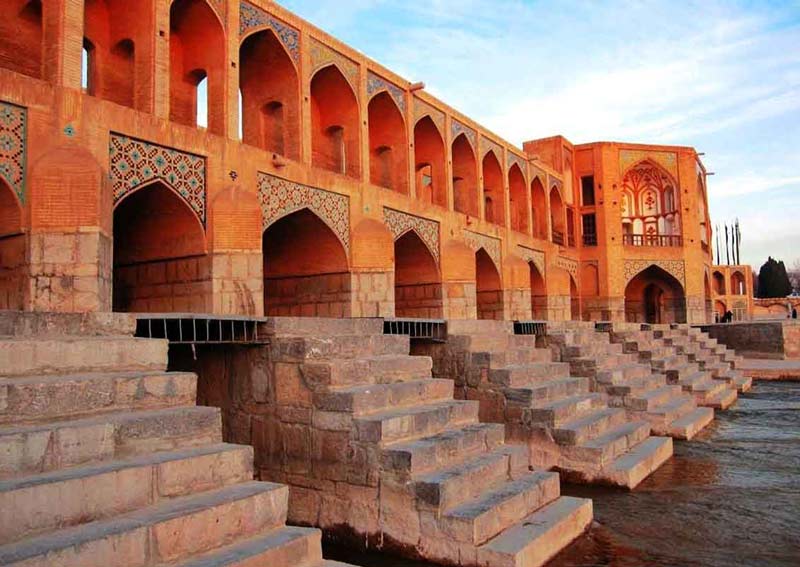
Materials used in construction
The bases are made of heavy and large stones. Their shape looks like stepped grooves.
A groove is a structure that directs the flow of water to the middle of the river. This structure reduces the speed of flow to maintain the edges.
3. Principles used in the construction of the Khaju Bridge
There are also some principles used in the construction of this bridge that add to its beauty:
The principle of symmetry in the architecture of the Khaju Bridge
All works of art, science, religion and philosophy and engineering in Iranian history show Iranian beliefs in symmetrical and orderly phenomena and structures.
The following types of symmetry are used:
- Transitional symmetry
- Reflective symmetry
- Circular symmetry
- Compound symmetry
- And ....
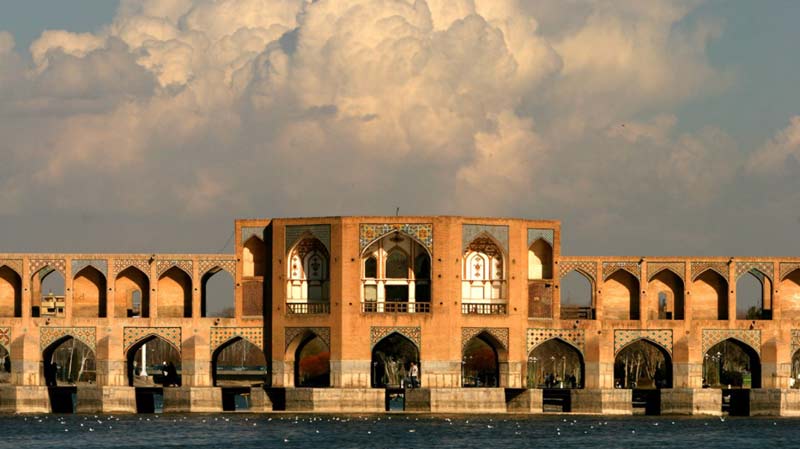
The design of Khaju Bridge is also a reflective symmetry or mirror symmetry that has its own beauty.
In reflective symmetry, the object is seen on both sides of a particular axis alike, but only reflected.
It means that it looks like half of the real object and the other half of the image is in the mirror.
To understand this kind of symmetry, you have to stand under the bridge. Here you will find hollows in the upper and middle parts of the bridge foundations along its eastern side.
You see that there are four hollows in all the halls. hollows are repeated with a regular rhythm along the eastern side.
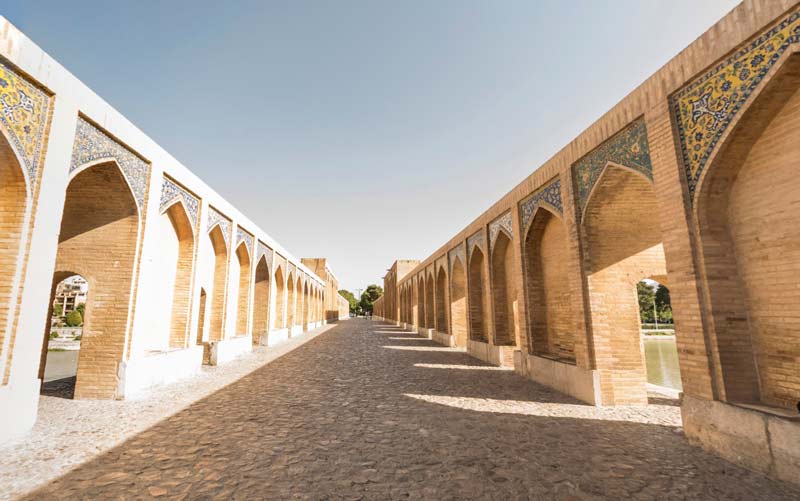
The principle of proportion in the Khaju Bridge
The principle of proportion in architecture is a something that creates a sense of order between the components of a composition visually. Khaju has taken advantage of this principle.
The bridge has a linear spatial arrangement. The result is a repetition of spaces of the same size and shape with the same function.
Underneath the bridge there are 21 corridors, separated by a distance. These halls are connected by a middle space.
The proportion of the middle spaces in terms of length and width has created the space needed to provide light and sight from both sides of the bridge. As a result, it brings an interesting view for the people.
4. Materials used in the Khaju Bridge; smart selections
Architectural experts cite Khaju Bridge as the pinnacle of Iran's bridge industry. They believe the materials used in the construction of this structure are very cleverly selected.
Here's a look at these materials:
Brick
Due to the presence of water, the use of clay in bridge construction does not make much sense. That's why brick is the best option.

stones
The use of stone in riverbeds, bridge foundation and even part of the wall and the body of the work is evident. This is a reasonable way to strengthen the bridge against the flow of water.
The use of stone in the pillars, in addition to the foundations, helps to strengthen the bridge. Therefore, it increases its resistance.
The stone within the foundations are like a rubble. To provide the required weight, the space between the arches is filled with rubble.
On the other hand, the corrosive effect of human traffic, livestock and carriages should also be compensated. To do this, they have also covered the floor of the bridge crossing with stone to create the necessary resistance.
The floor of the bridge to the river bed is 11 steps. They are all made of stone. The paving of the river floor, the stairs, the covering on the bases and the waterways, and the body of the pillars are also made of rubble stones and carved boulders.
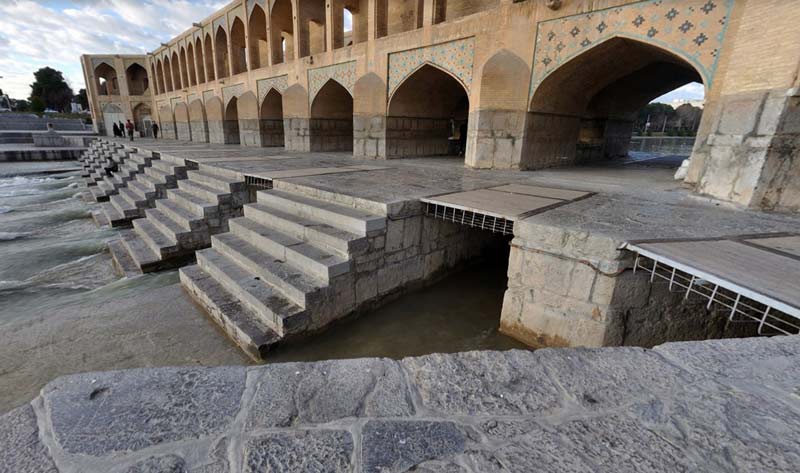
Mortar
Mortar used on bridges is very important. Water-resistant mortar should be used especially in areas such as pedestals and foundations that are in direct contact with water.
At this time, it is best to use lime mortar, especially stucco.
Stucco (Saroj) is one of the most ancient Iranian architectural innovations and a sign of their intelligence.
To make this mortar, first mix the clay and lime at a certain amount to achieve a solid clay. Then knead them for two days.
Other mortar used in the bridge is plaster used in the arches, walls, and ornamentation of the king rooms (middle space of the bridge).
Tiles
Brick tiles with a variety of designs have been used to adorn some parts of the bridge. The brick tile, also known as the seven colors, is made from a combination of fine bricks.
Each of them contains part of the design. Maqeli tile is a type of tile with geometric designs made by integrating geometric shapes.
Wood
Wood in structures dealing with water had a temporary use. These woods are embedded in the bridges behind the dam and used to close the dam openings.
When they wanted to form a lake behind the dam, they blocked the bridge with wooden valves.
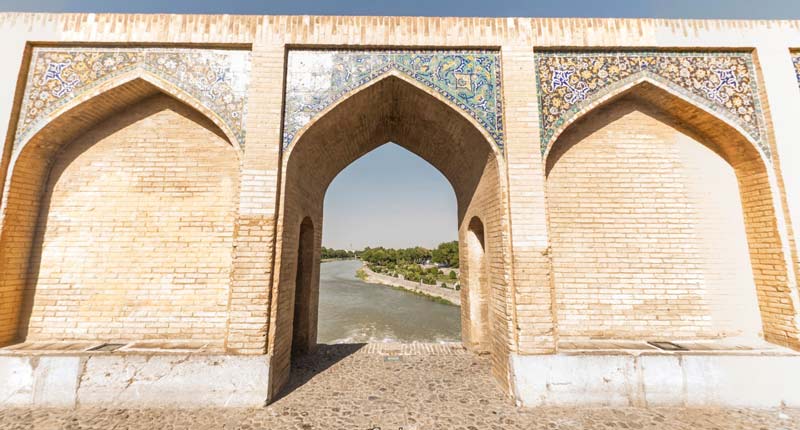
Khaju - a bridge that served as a dam
One of the most noteworthy point in the construction of the Khaju Bridge was to turn it into a dam when needed. The operation had the following benefits:
- A beautiful lake was created behind the bridge. The combination of that lake with the gardens around it created exquisite landscapes. On the other hand, it was the best place for recreations like boat riding.
- A reservoir was formed as the water accumulated. The dam's water was used during the summer months with water shortage.
- As the water level rises, rivers flowing from the lake bring water to the farmland and water it.
- With the closure of the openings and the increase in water pressure, the power needed to operate the windmills was provided.
- Water accumulation in the lake fed and reinforced the wells around the river and within the city.
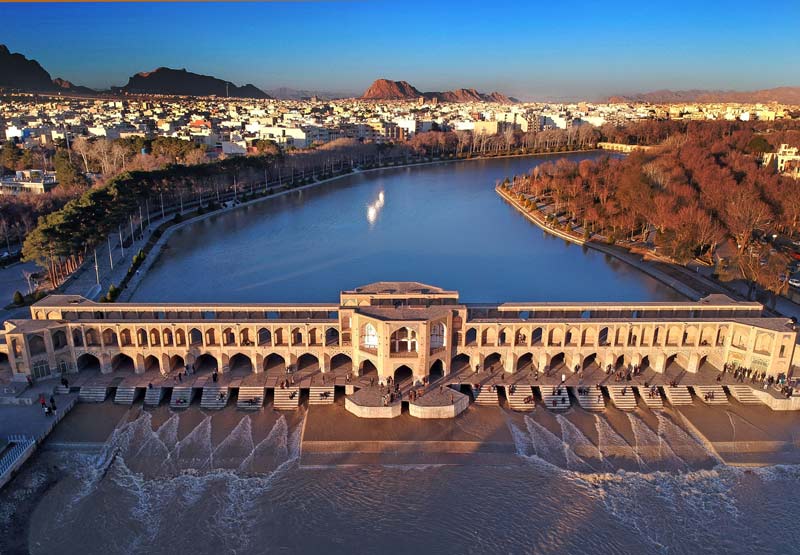
The way of turning a bridge into a dam
The question may arise in your mind how to use a bridge as a dam? Also how to turn it?
You have to know that there was a special system in place for this. The system could raise water to a height of 6 meters.
The bridge has 16 water drainage valves. At the bottom of it there was a wooden bar graded for hydrometry and water measurement.
To turn the bridge into a dam, slots were installed in the waterways of the bridge. To keep the wooden valves in it and prevent water from moving.
These valves block the water of the dam. As the water flowed upstream, a lake bridge formed. But it's not all that easy ...

Three stages and different levels were considered to close the waterways. During each step the water would rise to a certain height:
The first stage was below all, in the bottom of the dungeon. The wooden valve was sliding and diagonally in its place to prevent water from passing.
The second stage occurred in the upper part of the waterway. The valve was sliding but upright in the groove.
The third stage was the upper part of the waterway. The height of the water reached the bridge arches. At this stage, due to the large size of the lake and its powerful force, the back of the dam was used.
After placing the valve upright in the desired groove, two horizontal beams were placed behind the valve. The beams were positioned so that the two ends of the beams were placed on a stand at the base of the bridge.
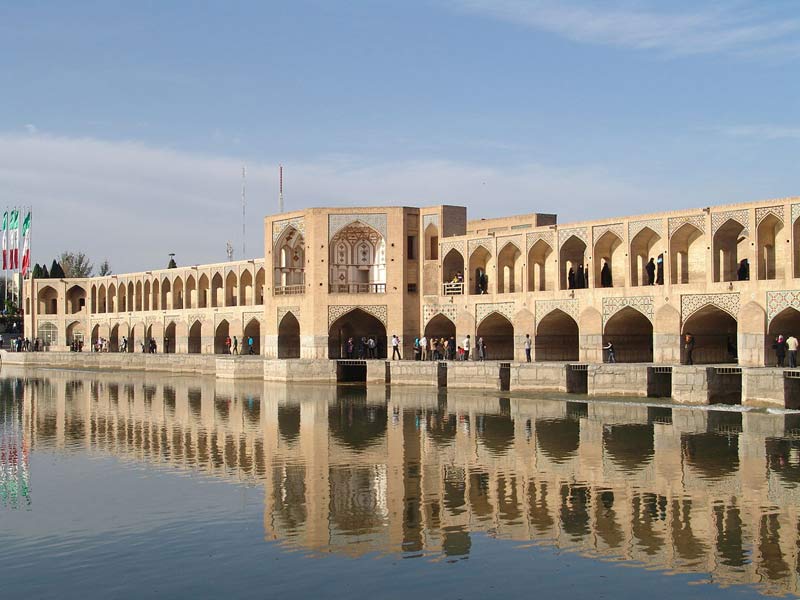
Khaju; the bridge that was the king's temporary residence
The Khaju Bridge has two eastern and western sides. Among each is a building called the Shah Neshin or Biglar Beigi with several rooms adorned with paintings.
Known as the Shah Neshin, the building served as a temporary residence for the Shah's family. It was also home to elders and emirs who came here to watch swimming and boating competitions of the artificial lake.
This artificial lake was formed by the blockage of the waterway by the bridge. It is said that there were also fountains around the bridge at that time, with no trace of them today.
Access ways to Khaju Bridge
Address: Khaju Bridge, Isfahan City, Isfahan Province
Khaju Bridge connects Kamal Esmail Street and Ayineh Khaneh Boulevard. So you can access it from any of these places.
Access with public vehicles
You can reach the Khaju Bridge using the city and subway buses. Here's how you can see them:
Bus
Use the lines that stop at Khaju Bridge Station. Take a short walk from Kamal Esmail Street to the bridge.
Subway
The nearest metro station to Khaju Bridge is Si-O-Se Pol. This station is about 2 km from your destination.
You have to take a taxi after getting off the subway. If you use this option, you will enter the bridge from the Ayineh Khaneh Boulevard.

Sites around Khaju Bridge
Isfahan's sites are endless. You can also visit other attractions besides visiting the Khaju Bridge in the city.
Here are some of the attractions and their distance to Khaju Bridge:
- Isfahan Flower Garden - 1.4 km
- Si-O-Se Pol - 2.6 km
- Naghsh-e Jahan Square - 2.8 km
- Chehelstoun - 3.2 km
- Hasht Behesht Palace - 3.8 km
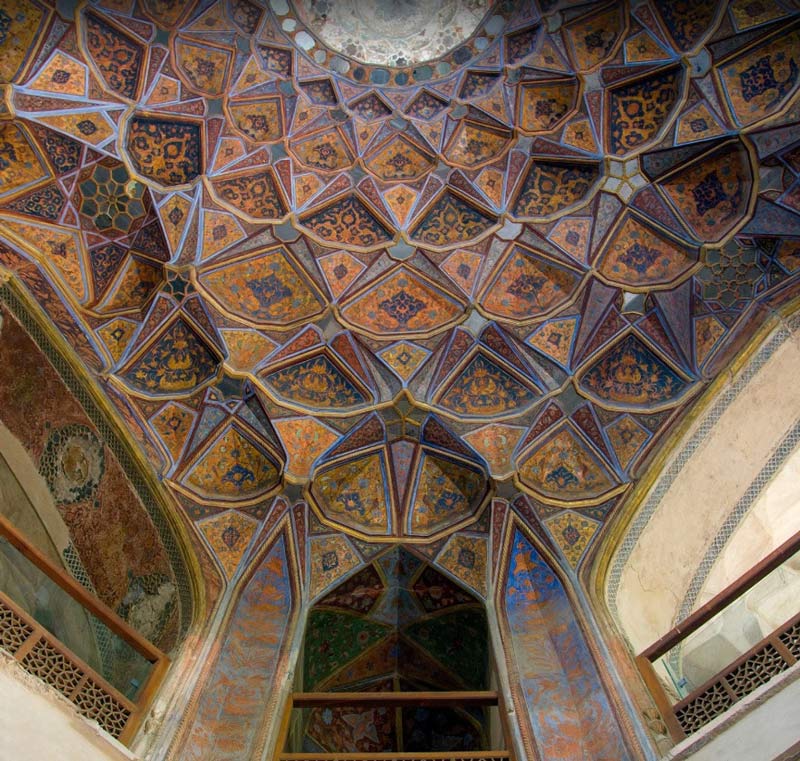
You can stay at the Abbasi Hotel in Isfahan to stay in Isfahan and also visit this beautiful bridge. If you have not yet booked your hotel, you can book the Abbasi Hotel in Isfahan now.
Foreigners' comments on Khaju Bridge
One of the things many of us are curious about is what foreigners think of our attractions. For example, from the viewpoint of a foreign tourist, what are the features of a foreign tourist and how attractive it is.
So here's a look at TripAdvisor, the Travel and Tourism website. Here are some foreign tourists' comments on Khaju bridge:
Dutch tourist - visiting time June 2019
extraordinary!
Attractive bridge with unique architecture. It is both worth visiting this bridge and enjoying the surrounding area. The water dance and the folks that come along the bridge and have fun singing are awesome. I highly recommend visiting this attraction.
Australian Tourist - Visiting time May 2019
Stunning at night
It's really worth seeing. Walk both above and below the bridge. There are beautiful gardens around this part of the river.
New Zealand Tourist - Visiting time May 2019
Magical at night
We went to the bridge in the month of Ramadan, after the weather was dark. The downstairs was full of people talking, eating, and singing.
The river was abnormally waterlogged and had an amazing sound. This work is really beautiful in architecture. You can see the amazing arches here.
The bridge is beautiful throughout the day but more vibrant at night. Don't miss this attraction.
Tourist from Montenegro - Visiting time June 2019
Extraordinary
This old bridge has a very beautiful look. People gather near this bridge because it is cooler than other parts of Isfahan.
Dutch tourist - Visiting time June 2019
The Best Isfahan’s Bridge
We went to the bridge on Thursday afternoon. There was a lot of water flowing in the river, which was not normal. People gathered under the bridge, singing and dancing. It was an attractive space.
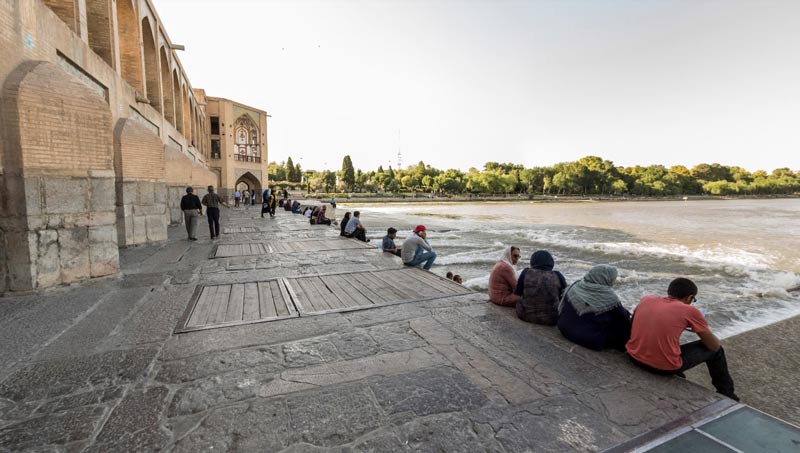
HotelOneClick Concerns
The preservation and restoration of monuments is one of the most important issues that everyone is responsible for. Writing something or carving is like scars on the culture and history of the country. This will shorten the life of these valuable works.
On the other hand, the old stones of the old stairs were replaced with new ones in order to restore the bridge. This work has always been criticized for damaging the originality of this authentic Iranian building.
The issue of blocking water in addition to damaging the environment also endangers the life of the bridge that needs more and more attention.
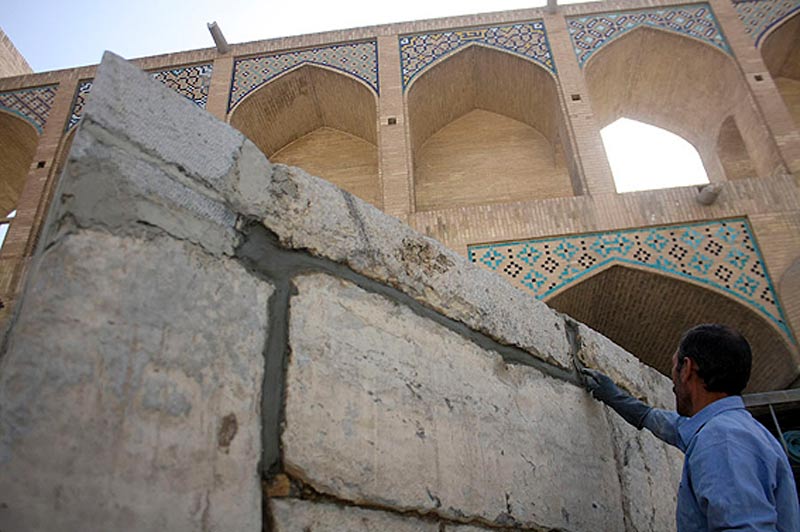
Conclusions on Khaju bridge Tourism Guide
Historic bridges are important sights of Isfahan. Your journey is completed with them. The Khaju Bridge is among the most beautiful of these bridges. So don't miss seeing it.
If you've ever visited this bridge, share your ideas with us.
What do you know about other historic bridges in Iran?
If you have questions about this bridge or other bridges in Iran, please write in the comments section. Out team at the HotelOneClick will respond to you.
We look forward to your views.
Our references to prepare Khaju bridge Travel guide:
we have used many references to prepare this article. They are some of them in the following:
